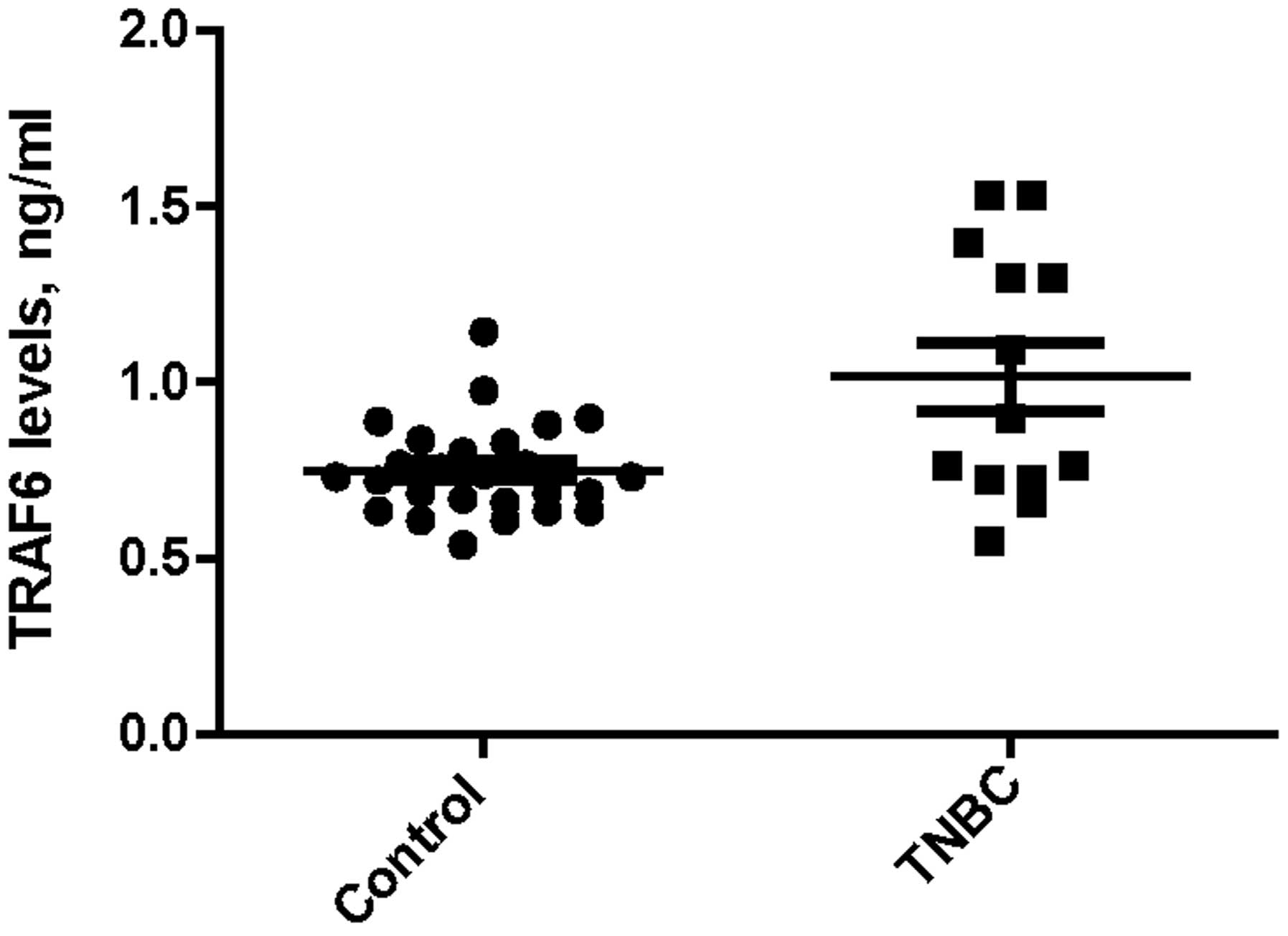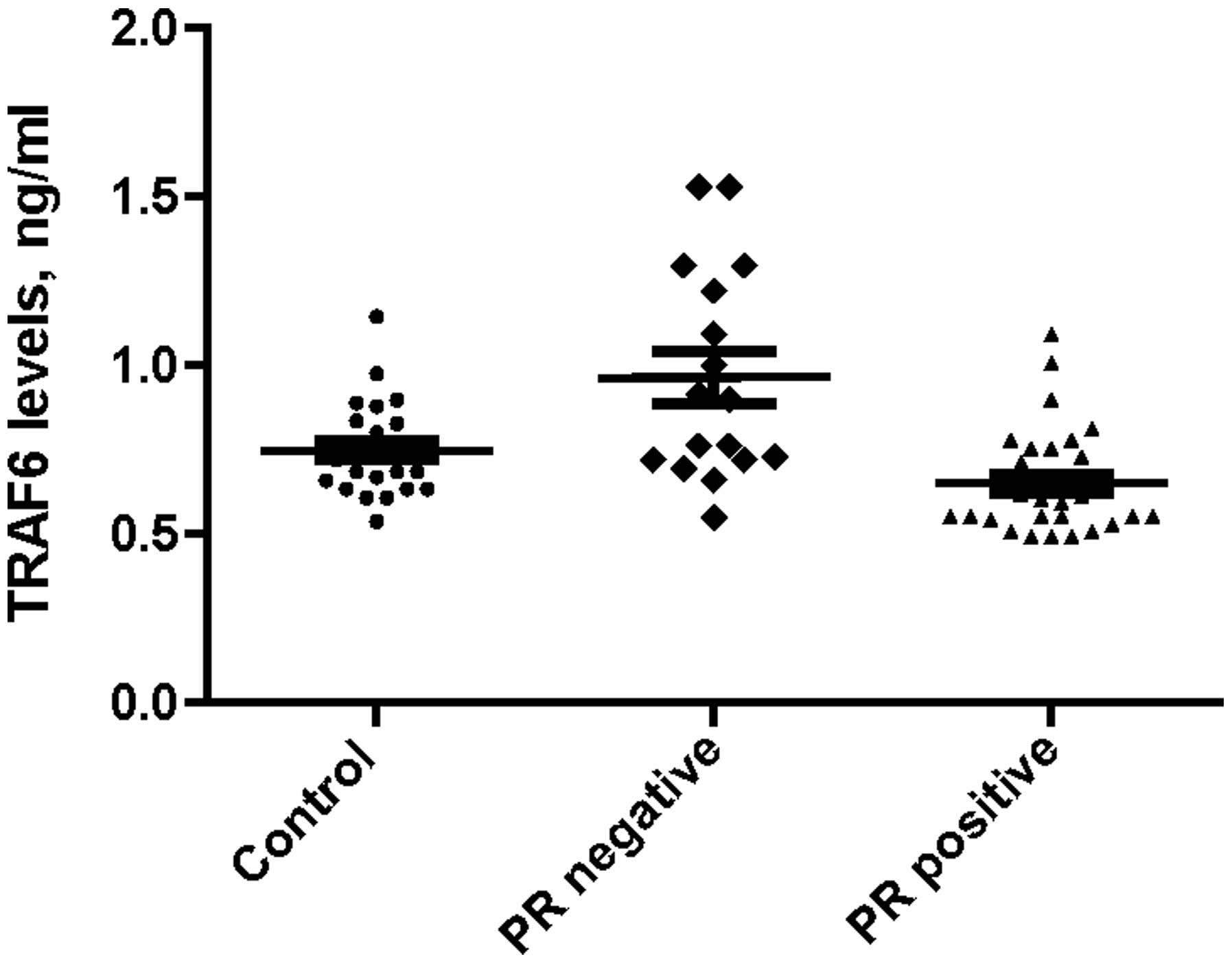|
1
|
Rose DP, Gilhooly EM and Nixon DW: Adverse
effects of obesity on breast cancer prognosis and the biological
actions of leptin (Review). Int J Oncol. 21:1285–1292.
2002.PubMed/NCBI
|
|
2
|
Majed B, Moreau T, Senouci K, et al: Is
obesity an independent prognosis factor in woman breast cancer?
Breast Cancer Res Treat. 111:329–342. 2008. View Article : Google Scholar : PubMed/NCBI
|
|
3
|
de Azambuja E, McCaskill-Stevens W,
Francis P, et al: The effect of body mass index on overall and
disease-free survival in node-positive breast cancer patients
treated with docetaxel and doxorubicincontaining adjuvant
chemotherapy: The experience of the BIG 02–98 trial. Breast Cancer
Res Treat. 119:145–53. 2010. View Article : Google Scholar : PubMed/NCBI
|
|
4
|
Sestak I, Distler W, Forbes JF, et al:
Effect of body mass index on recurrences in tamoxifen and
anastrozole treated women: an exploratory analysis from the ATAC
trial. J Clin Oncol. 28:3411–3415. 2010. View Article : Google Scholar : PubMed/NCBI
|
|
5
|
Sparano JA, Wang M, Zhao F, et al: Obesity
at diagnosis is associated with inferior outcomes in hormone
receptor-positive operable breast cancer. Cancer. 118:5937–5946.
2012. View Article : Google Scholar : PubMed/NCBI
|
|
6
|
Pierobon M and Frankenfeld CL: Obesity as
a risk factor for triple-negative breast cancers: a systematic
review and meta-analysis. Breast Cancer Res Treat. 137:307–314.
2013. View Article : Google Scholar : PubMed/NCBI
|
|
7
|
Vona-Davis L and Rose DP: Adipokines as
endocrine, paracrine and autocrine factors in breast cancer risk
and progression. Endocr Relat Cancer. 14:189–206. 2007. View Article : Google Scholar : PubMed/NCBI
|
|
8
|
Schäffler A, Schölmerich J and Buechler C:
Mechanisms of disease: adipokines and breast cancer - endocrine and
paracrine mechanisms that connect adiposity and breast cancer. Nat
Clin Pract Endocrinol Metab. 3:345–354. 2007. View Article : Google Scholar : PubMed/NCBI
|
|
9
|
Stephenson GD and Rose DP: Breast cancer
and obesity: an update. Nutr Cancer. 45:1–16. 2003. View Article : Google Scholar : PubMed/NCBI
|
|
10
|
Weichhaus M, Broom I and Bermano G: The
molecular contribution of TNF-α in the link between obesity and
breast cancer. Oncol Rep. 25:477–483. 2011.PubMed/NCBI
|
|
11
|
Chicheportiche Y, Bourdon PR, Xu H, et al:
TWEAK, a new secreted ligand in the tumor necrosis factor family
that weakly induces apoptosis. J Biol Chem. 272:32401–32410. 1997.
View Article : Google Scholar : PubMed/NCBI
|
|
12
|
Winkles JA: The TWEAK-Fn14
cytokine-receptor axis: discovery, biology and therapeutic
targeting. Nat Rev Drug Discov. 7:411–425. 2008. View Article : Google Scholar : PubMed/NCBI
|
|
13
|
Kawakita T, Shiraki K, Yamanaka Y, et al:
Functional expression of TWEAK in human colonic adenocarcinoma
cells. Int J Oncol. 26:87–93. 2005.PubMed/NCBI
|
|
14
|
Kawakita T, Shiraki K, Yamanaka Y, et al:
Functional expression of TWEAK in human hepatocellular carcinoma:
possible implication in cell proliferation and tumor angiogenesis.
Biochem Biophys Res Commun. 318:726–733. 2004. View Article : Google Scholar : PubMed/NCBI
|
|
15
|
Pickart CM: Mechanisms underlying
ubiquitination. Annu Rev Biochem. 70:503–533. 2001. View Article : Google Scholar : PubMed/NCBI
|
|
16
|
Mukhopadhyay D and Riezman H:
Proteasome-independent functions of ubiquitin in endocytosis and
signaling. Science. 315:201–205. 2007. View Article : Google Scholar : PubMed/NCBI
|
|
17
|
Paul PK, Gupta SK, Bhatnagar S, et al:
Targeted ablation of TRAF6 inhibits skeletal muscle wasting in
mice. J Cell Biol. 191:1395–1411. 2010. View Article : Google Scholar : PubMed/NCBI
|
|
18
|
Tavassoli FA and Devilee P: Tumours of the
breastWorld Health Organization Classification of Tumours.
Pathology and Genetics of Tumours of the Breast and Female Genital
Organs. IARC Press; Lyon: pp. 13–59. 2003
|
|
19
|
Oken MM, Creech RH, Tormey DC, et al:
Toxicity and response criteria of the Eastern Cooperative Oncology
Group. Am J Clin Oncol. 5:649–655. 1982. View Article : Google Scholar : PubMed/NCBI
|
|
20
|
Johns N, Stephens NA and Preston T: Muscle
protein kinetics in cancer cachexia. Curr Opin Support Palliat
Care. 6:417–423. 2012. View Article : Google Scholar : PubMed/NCBI
|
|
21
|
Cohen S, Brault JJ, Gygi SP, et al: During
muscle atrophy, thick, but not thin, filament components are
degraded by MuRF1-dependent ubiquitylation. J Cell Biol.
185:1083–1095. 2009. View Article : Google Scholar : PubMed/NCBI
|
|
22
|
Acharyya S and Guttridge DC: Cancer
cachexia signaling pathways continue to emerge yet much still
points to the proteasome. Clin Cancer Res. 13:1356–1361. 2007.
View Article : Google Scholar : PubMed/NCBI
|
|
23
|
Lee SJ and Glass DJ: Treating cancer
cachexia to treat cancer. Skelet Muscle. 1:22011. View Article : Google Scholar : PubMed/NCBI
|
|
24
|
Fischer P and Hilfiker-Kleiner D: Survival
pathways in hypertrophy and heart failure: the gp130-STAT3 axis.
Basic Res Cardiol. 102:279–297. 2007. View Article : Google Scholar : PubMed/NCBI
|
|
25
|
Jones SA, Scheller J and Rose-John S:
Therapeutic strategies for the clinical blockade of IL-6/gp130
signaling. J Clin Invest. 121:3375–3383. 2011. View Article : Google Scholar : PubMed/NCBI
|
|
26
|
Penna F, Costamagna D, Fanzani A, Bonelli
G, Baccino FM and Costelli P: Muscle wasting and impaired
myogenesis in tumor bearing mice are prevented by ERK inhibition.
PLoS One. 5:136042010. View Article : Google Scholar
|
|
27
|
Jagoe RT and Goldberg AL: What do we
really know about the ubiquitin-proteasome pathway in muscle
atrophy? Curr Opin Clin Nutr Metab Care. 4:183–190. 2001.
View Article : Google Scholar : PubMed/NCBI
|
|
28
|
Lecker SH, Solomon V, Mitch WE and
Goldberg AL: Muscle protein breakdown and the critical role of the
ubiquitin-proteasome pathway in normal and disease states. J Nutr.
(Suppl):129:227S–237S. 1999.PubMed/NCBI
|
|
29
|
Bodine SC, Latres E, Baumhueter S, et al:
Identification of ubiquitin ligases required for skeletal muscle
atrophy. Science. 294:1704–1708. 2001. View Article : Google Scholar : PubMed/NCBI
|
|
30
|
Pickart CM: Mechanisms underlying
ubiquitination. Annu Rev Biochem. 70:503–533. 2001. View Article : Google Scholar : PubMed/NCBI
|
|
31
|
Yang WL, Wang J, Chan CH, et al: The E3
ligase TRAF6 regulates Akt ubiquitination and activation. Science.
325:1134–1138. 2009. View Article : Google Scholar : PubMed/NCBI
|
|
32
|
Yamashita M, Fatyol K, Jin C, Wang X, Liu
Z and Zhang YE: TRAF6 mediates Smad-independent activation of JNK
and p38 by TGF-beta. Mol Cell. 31:918–924. 2008. View Article : Google Scholar : PubMed/NCBI
|
|
33
|
Yamamoto M, Ito T, Shimizu T, et al:
Epigenetic alteration of the NF-κB-inducing kinase (NIK) gene is
involved in enhanced NIK expression in basal-like breast cancer.
Cancer Sci. 101:2391–2397. 2010. View Article : Google Scholar : PubMed/NCBI
|
|
34
|
Arsenic R, Lehmann A, Budczies J, et al:
Analysis of PIK3CA mutations in breast cancer subtypes. Appl
Immunohistochem Mol Morphol. 22:50–56. 2014. View Article : Google Scholar : PubMed/NCBI
|
|
35
|
Polek TC, Talpaz M, Darnay BG and
Spivak-Kroizman T: TWEAK mediates signal transduction and
differentiation of RAW264.7 cells in the absence of Fn14/TweakR.
Evidence for a second TWEAK receptor. J Biol Chem. 278:32317–32323.
2003. View Article : Google Scholar : PubMed/NCBI
|
|
36
|
Yoriki R, Akashi S, Sho M, et al:
Therapeutic potential of the TWEAK/Fn14 pathway in intractable
gastrointestinal cancer. Exp Ther Med. 2:103–108. 2011.PubMed/NCBI
|
|
37
|
Chao DT, Su M, Tanlimco S, et al:
Expression of TweakR in breast cancer and preclinical activity of
enavatuzumab, a humanized anti-TweakR mAb. J Cancer Res Clin Oncol.
139:315–325. 2013. View Article : Google Scholar : PubMed/NCBI
|
|
38
|
Chacón MR, Richart C, Gómez JM, et al:
Expression of TWEAK and its receptor Fn14 in human subcutaneous
adipose tissue. Relationship with other inflammatory cytokines in
obesity. Cytokine. 33:129–137. 2006. View Article : Google Scholar : PubMed/NCBI
|
|
39
|
Liu H, Tamashiro S, Baritaki S, et al:
TRAF6 activation in multiple myeloma: a potential therapeutic
target. Clin Lymphoma Myeloma Leuk. 12:155–163. 2012. View Article : Google Scholar : PubMed/NCBI
|
|
40
|
Hongming H and Jian H: Bortezomib inhibits
maturation and function of osteoclasts from PBMCs of patients with
multiple myeloma by downregulating TRAF6. Leuk Res. 33:115–122.
2009. View Article : Google Scholar : PubMed/NCBI
|
|
41
|
Tseng LM, Liu CY, Chang KC, Chu PY, Shiau
CW and Chen KF: CIP2A is a target of bortezomib in human triple
negative breast cancer cells. Breast Cancer Res. 14:R682012.
View Article : Google Scholar : PubMed/NCBI
|
















